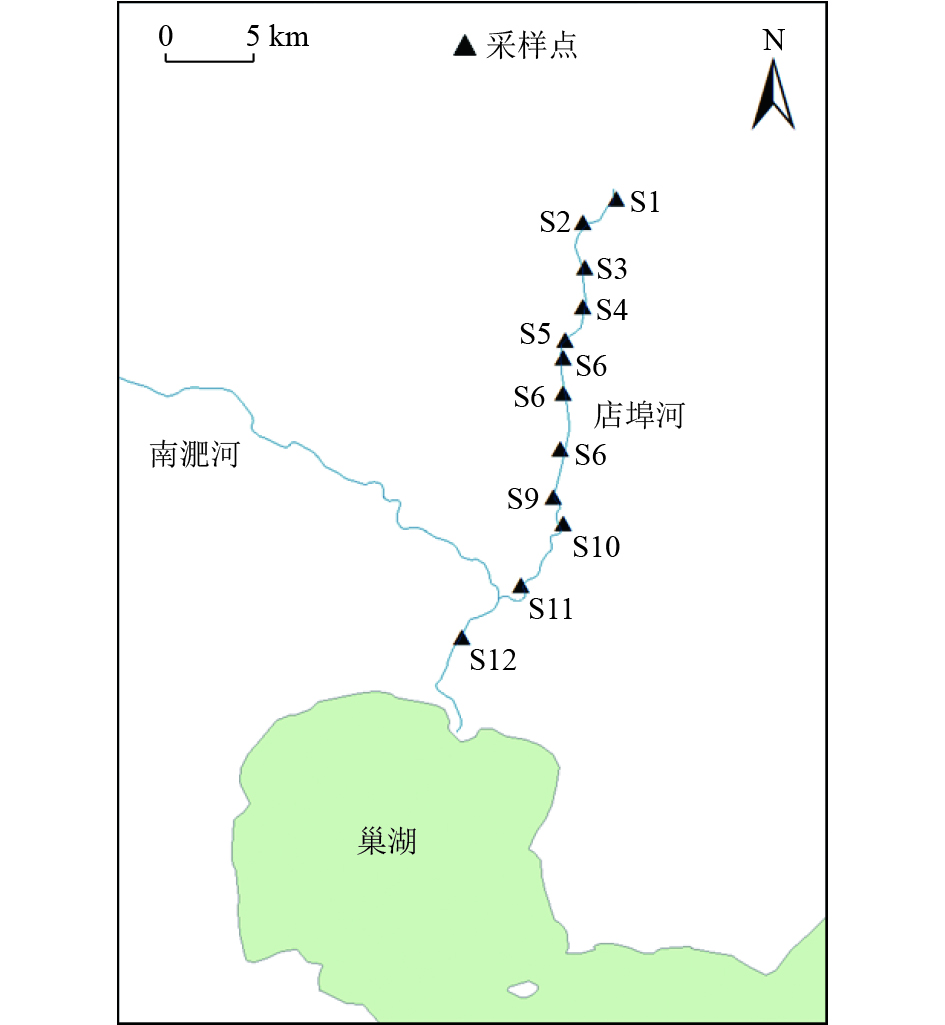Application of equilibrium partitioning approach to derive sediment quality guideline (SQG) values for heavy metals in the Dianbu River
-
摘要:
以店埠河为研究对象,采用校正后的相平衡分配法推导了店埠河沉积物中5种重金属(Cr、Cu、Zn、Cd、Pb)的沉积物质量基准(SQG)值,并分析了各金属结合相对不同重金属沉积物质量基准的贡献。结果表明:店埠河沉积物中Cr、Cu、Zn、Cd和Pb的沉积物质量基准值分别为318.80、122.24、1 326.99、7.88和31.43 mg/kg;各金属结合相对不同重金属的沉积物质量基准值的贡献存在差异,细颗粒物(粒径<63 μm)对店埠河5种重金属沉积物质量基准值的贡献率为24.49%~48.93%,其中对Cr、Zn和Cu的沉积物质量基准值的贡献最大。酸可挥发性硫化物对Cu、Zn、Cd和Pb的沉积物质量基准值的贡献率分别为2.11%、0.22%、50.13%和21.67%,主要决定着Cd的SQG。总有机碳和残渣态对这5种重金属SQG的贡献率较低,均不足3%。
Abstract:The Dianbu River was taken as the study object, the normalized equilibrium partitioning approach was used to derive the sediment quality guideline (SQG) values of five heavy metals (Cr, Cu, Zn, Cd, Pb) in the sediments of the river, and the contribution of each metal binding phase to the SQG value for five different heavy metals was analyzed. The results showed that the SQG values of Cr, Cu, Zn, Cd, and Pb in the sediments of the Dianbu River were 318.80, 122.24, 1 326.99, 7.88 and 31.43 mg/kg, respectively. There were differences in the contribution of each metal binding phase to the SQG values of five heavy metals. The contribution rate of fine particulate material (particle size < 63 μm) to the SQG values of five heavy metals in the sediments of the Dianbu River was 24.49%-48.93%, and the contribution rate to the SQG values of Cr, Zn and Cu sediments were the largest. The contribution rate of acid volatile sulfide to the SQG values of Cu, Zn, Cd and Pb was 2.11%, 0.22%, 50.13% and 21.67%, respectively, which mainly determined the SQG value of Cd. Total organic carbon and residual state contributed less than 3% to the SQG values of these five heavy metals.
-
表 1 店埠河重金属沉积物质量基准推导模型
Table 1. Derivation models of heavy metal SQG values in the Dianbu River
重金属 推导模型 Pb,Cu SQG=Kp×WQC×(1+A%+B%)+$ \dfrac{1}{n} $×AVS×lgKp/ΣlgKp×M+MR(1−A%) Zn,Cd SQG=Kp×WQC×(1+A%)+$ \dfrac{1}{n} $×AVS×lgKp/ΣlgKp×M+MR(1−A%) Cr SQG =Kp×WQC×(1+A%)+MR(1−A%) 表 2 店埠河重金属相平衡分配系数
Table 2. Kp of heavy metals in the Dianbu River
重金属 MR/(mg/kg) CS/(mg/kg) CIW/(μg/L) Kp/(L/kg) logKp 取值范围 平均值 取值范围 平均值 取值范围 平均值 平均值 Cr 32.08~64.95 54.01 2.40~27.18 10.48 0.10~0.88 0.65 16123.1 4.21 Cu 10.75~35.55 20.95 11.38~48.27 25.31 2.70~5.68 4.24 5969.3 3.78 Zn 21.84~175.45 77.61 14.25~2090.80 437.62 9.19~55.49 32.55 13444.6 4.13 Cd 0.01~0.08 0.03 0.29~2.10 0.78 0.04~0.65 0.39 2000 3.30 Pb 14.30~36.39 20.90 10.30~38.05 21.59 16.79~19.47 17.99 1200.1 3.08 表 3 店埠河沉积物中各金属结合相的浓度
Table 3. Contents of metal binding phases in sediments of the Dianbu River
采样点 细颗粒物/% TOC/% AVS/(μmol/g) MR/(mg/kg) Cr Cu Zn Cr Pb S1 95.89 2.23 0.58 32.08 10.75 21.84 0.0055 14.30 S2 96.67 2.69 0.46 44.84 14.62 142.13 0.0115 18.16 S3 92.56 3.67 0.23 62.59 21.93 175.45 0.0285 18.55 S4 97.87 2.98 0.16 40.35 14.58 82.00 0.0130 17.38 S5 98.12 4.12 0.78 57.36 17.51 54.01 0.0180 23.27 S6 97.33 1.97 0.89 64.95 24.49 72.56 0.0330 22.06 S7 97.34 2.67 1.47 64.70 25.74 63.43 0.0250 18.10 S8 96.23 2.55 0.67 54.32 35.55 101.02 0.0775 36.39 S9 96.76 2.19 0.55 58.22 20.42 67.74 0.0165 20.87 S10 94.67 1.78 0.49 50.04 18.08 47.82 0.0310 19.29 S11 97.38 2.78 0.82 58.33 20.37 53.99 0.0245 16.21 S12 98.11 2.54 0.24 60.34 27.30 49.38 0.0265 26.25 平均值 96.58 2.68 0.61 54.01 20.95 77.61 0.0259 20.90 表 4 店埠河重金属的沉积物质量基准推导和标准化结果
Table 4. Derivation and standardization results of SQG values for heavy metals in the Dianbu River
mg/kg 校正项 Cr Cu Zn Cd Pb Kp×WQC值 161.23 59.69 672.23 2.00 12.00 细颗粒物校正值 155.72 57.65 649.24 1.93 11.59 TOC校正值 — 1.60 — — 0.32 AVS校正值 — 2.58 2.87 3.95 6.81 残渣态校正值 1.85 0.72 2.65 — 0.71 SQG 318.80 122.24 1 326.99 7.88 31.43 表 5 不同水体重金属的沉积物质量基准
Table 5. SQG values for heavy metals in different water bodies
mg/kg 水体 Cr Cu Pb Zn Cd 数据来源 店埠河 318.80 122.24 31.43 1 326.99 7.88 本研究 巢湖 78.53 56.95 362.93 74.68 23.90 文献[14] 太湖 — 55.3 20.6 201.5 6.42 文献[12] 辽河 — 52.8 18.9 177.7 5.42 文献[12] 鄱阳湖 — 59.93 76.13 109.32 3.50 文献[13] 湘江衡阳段(基于
地表水Ⅰ类标准)— 64.62 55.57 1 360.40 2.34 文献[11] LEL 26 16 31 120 0.6 文献[22] SEL 110 110 250 820 10 文献[22] ERL 81 34 46.7 150 1.2 文献[22] ERM 370 270 218 410 9.6 文献[22] 注:LEL表示最低效应水平;SEL表示严重效应水平;ERL表示效应范围低值;ERM表示效应范围中值。 -
[1] 高秋生, 田自强, 焦立新,等. 白洋淀重金属污染特征与生态风险评价[J]. 环境工程技术学报,2019,9(1):66-75. doi: 10.3969/j.issn.1674-991X.2019.01.010GAO Q S, TIAN Z Q, JIAO L X, et al. Pollution characteristics and ecological risk assessment of heavy metals in Baiyangdian Lake[J]. Journal of Environmental Engineering Technology,2019,9(1):66-75. doi: 10.3969/j.issn.1674-991X.2019.01.010 [2] HUANG Z, LIU C, ZHAO X, et al. Risk assessment of heavy metals in the surface sediment at the drinking water source of the Xiangjiang River in South China[J]. Environmental Sciences Europe,2020,32:1-9. doi: 10.1186/s12302-019-0282-1 [3] 符运拓, 杨红, 王春峰. 长江口邻近海域表层沉积物重金属赋存形态及生态危害评估[J]. 海洋环境科学,2022,41(4):534-542.FU Y T, YANG H, WANG C F. The occurrence forms and ecological hazard evaluation of heavy metals in the surface sediments near the Yangtze Estuary[J]. Marine Environmental Science,2022,41(4):534-542. [4] 吴斌, 宋金明, 李学刚, 等. 一致性沉积物质量基准 (CBSQGs) 及其在近海沉积物环境质量评价中的应用[J]. 环境化学,2011,30(11):1949-1956.WU B, SONG J M, LI X G, et al. Consistent sediment quality standards (CBSQGs) and their application in environmental quality assessment of offshore sediments[J]. Environmental Chemistry,2011,30(11):1949-1956. [5] 钟文珏, 曾毅, 祝凌燕. 水体沉积物质量基准研究现状[J]. 生态毒理学报,2013,8(3):285-294. doi: 10.7524/AJE.1673-5897.20111113003ZHONG W Y, ZENG Y, ZHU L Y. Current research status of sediment quality criteri[J]. Asian Journal of Ecotoxicology,2013,8(3):285-294. doi: 10.7524/AJE.1673-5897.20111113003 [6] 陈静生, 王飞越. 关于水体沉积物质量基准问题[J]. 环境化学,1992,11(3):60-70.CHEN J S, WANG F Y. On the issue of sediment quality standards for water bodies[J]. Environmental Chemistry,1992,11(3):60-70. [7] BROWN T N. QSPRs for predicting equilibrium partitioning in solvent–air systems from the chemical structures of solutes and solvents[J]. Journal of Solution Chemistry,2022,51(9):1101-1132. doi: 10.1007/s10953-022-01162-2 [8] BARRICK R, BELLER H, BECKER S. Use of the apparent effects threshold approach (AET) in classifying contaminated sediments[M]//Contaminated marine sediments:assessment and remediation.Washington DC:National Academy Press, 1989:64-77. [9] NEFF J M, CORNABY B W, VAGA R M, et al. An evaluation of the screening level concentration approach for validation of sediment quality criteria for freshwater and saltwater ecosystems[M]. ASTM International, 1988. [10] LONG E R. The potential for biological effects of sediment-sorbed contaminants tested in the National Status and Trends Program[M]. US Department of Commerce, National Oceanic and Atmospheric Administration, National Ocean Service, 1990. [11] HAN C, QIN Y, ZHENG B, et al. Sediment quality assessmentfor heavy metal pollution in the Xiang-jiang River (China) withthe equilibrium partitioning approach[J]. Environmental Earthsciences,2014,72:5007-5018. [12] 邓保乐, 祝凌燕, 刘慢, 等. 太湖和辽河沉积物重金属质量基准及生态风险评估[J]. 环境科学研究,2011,24(1):33-42. doi: 10.13198/j.res.2011.01.35.dengby.015DENG B L, ZHU L Y, LIU M, et al. Sediment quality criteria and ecological risk assessment for heavy metalsin Taihu Lake and Liao River[J]. Research of Environmental Sciences,2011,24(1):33-42. doi: 10.13198/j.res.2011.01.35.dengby.015 [13] 江良, 弓晓峰, 袁少芬, 等. 鄱阳湖沉积物重金属质量基准研究及其生态风险评估[J]. 环境污染与防治, 2020, 42(1): 94-100.JIANG L, GONG X F, YUAN S F, et al. Study on the sediment quality criteria and ecological risk assessment for heavy metals in Poyang Lake [J] Environmental Pollution & Control, 2020, 42(1): 94-100. [14] HUO S, XI B, YU X, et al. Application of equilibrium partitioning approach to derive sediment quality criteria for heavy metals in a shallow eutrophic lake, Lake Chaohu, China[J]. Environmental Earth Sciences,2013,69:2275-2285. doi: 10.1007/s12665-012-2056-6 [15] 王静, 叶寅, 王允青, 等. 利用氮氧同位素示踪技术解析巢湖支流店埠河硝酸盐污染源[J]. 水利学报,2017,48(10):1195-1205.WANG J, YE Y, WANG Y Q, et al. Analysis of nitrate pollution sources in Dianbu River, a tributary of Chaohu Lake, using nitrogen and oxygen isotope tracing technology[J]. Journal of Hydraulic Engineering,2017,48(10):1195-1205. [16] 彭浩. 合肥市店埠河流域乡村面源污染现状分析与防治对策[J]. 安徽农学通报,2018,24(17):1-4.PENG H. Analysis and prevention measures of rural non-point source pollution in Dianbu River Basin[J]. Anhui Agricultural Science Bulletin,2018,24(17):1-4. [17] 张蕾. 巢湖沉积物重金属污染特征研究[D]. 北京: 北京交通大学, 2009. [18] DITORO D M, MAHONY J D, HANSEN D J, et al. Acid volatile sulfide predicts the acute toxicity of cadmium and nickel in sediments[J]. Environmental Science & Technology,1992,26(1):96-101. [19] BROWN R H, BAKER D J, WILSON W S. The Utility of AVS/EqP in hazardous waste site evaluations[M]. Washington: NOAA Technical Memorandum Seattle, 1995: 101. [20] YUN Z C, HAO Y, ZHANG Z K, et al. Application of equilibrium partitioning approach to the derivation of sedimentquality guidelines for metals in Dianchi Lake[J]. Pedosphere,2007,17(3):284-294. doi: 10.1016/S1002-0160(07)60035-6 [21] TESSIER A, CAMPBELL P G C, AUCLAIR J C, et al. Relationships between the partitioning of trace metals in sediments and their accumulation in the tissues of the freshwater mollusc Elliptio complanata in a mining area[J]. Canadian Journal of Fisheries and Aquatic Sciences,1984,41(10):1463-1472. doi: 10.1139/f84-180 [22] MACDONALD D D, INGERSOLL C G, BERGER T A. Development and evaluation of consensus-based sediment quality guidelines for freshwater ecosystems[J]. Archives of Environmental Contamination and Toxicology,2000,39:20-31. ⊕ doi: 10.1007/s002440010075 -





 下载:
下载:



